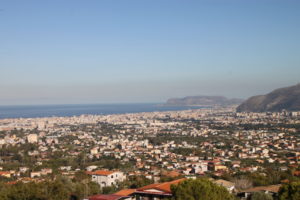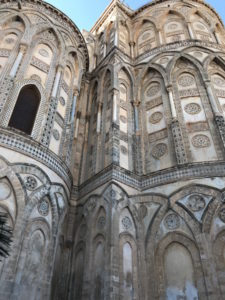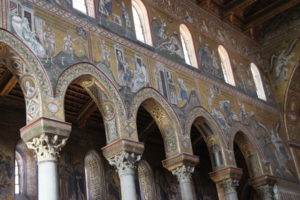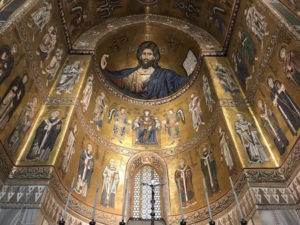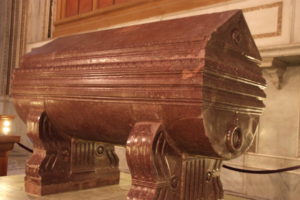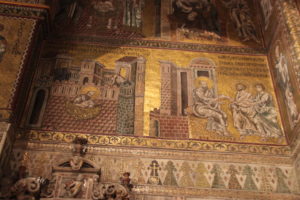One of the top tourist attractions in Palermo, Sicily, isn’t in town. It is the suburban UNESCO-protected Monreale Cathedral, a medieval structure boasting interior walls literally encrusted with mosaics and a lot of gold. I had to see it.
On arrival in Palermo, my hotel’s manager, Giuseppe, recommended restaurants (it was lunchtime) and gave advice for getting to Monreale. He suggested skipping public transportation in favor of one of several bus services that carry tourists to and from Monreale a few miles south of the city.
I was traveling with two friends. They were more interested in lunch and in-town activities. I left them and, per Giuseppe’s advice, walked to a spot directly behind the city’s 11th century Norman castle (now used by the Sicilian Parliament) looking for tour buses.
At least three companies provide regular tourist runs from central Palermo to Monreale. I bought a ticket (10 euros) for the first bus I found, which was set to leave soon. I was very lucky.
The Monreale-bound bus had only three passengers, plus driver and a hostess who provided some narration along the route.
My bus, like those operated by other travel companies, deposited its passengers at a point fairly close to the cathedral but with some uphill walking required (roughly 10 minutes) to the cathedral entry.
The town of Monreale and its cathedral are perched about a thousand feet above sea level. The walks to and from the church offered great views over the valley below (known for its fertility — almond, olive and orange trees) and, beyond that, the city of Palermo and its harbor.
My bus and the hostess stayed in place for one hour, which gave me 40 minutes inside and around the cathedral, after allowing for the 10-minute walks each way. That was not much time for a spectacular church interior, but I was glad to get there at all.
This was all about a Norman cathedral (with Arab and Byzantine influences, my guidebook and local printed materials said) that dates from the late 12th century. The cathedral’s rather plain-looking front faced Piazza Guglielmo II, a charming square with the de rigueur outdoor cafes soaked in sunshine.
Surprisingly, it was the cathedral’s backside, the apse exterior, that was showy. Blind arches were vivid and ornate because builders used inlay techniques with marble and tufa of various colors to good effect.
But the inside! Enter and let your jaw drop.
Here were 6,400 square meters, or more than 68,000 square feet, of mosaics covering every surface of the interior, meaning all of the surfaces above the marble (maybe 10 feet high) that lined the walls from the floor up.
Builders used the mosaics to tell Biblical stories in bright-colored glass pieces. The figures were set against a gold background (meaning gold leaf on glass). The Old Testament stories were featured in the nave, with stories of Christ’s life in the aisles and transept.
But, the gold was particularly vivid in the apse, meaning the space around and encompassing the altar. I paid the 2.50 euros to visit this extraordinary section. This was my only on-site expense. Entry to the cathedral was free, and I did not have time for more options that involved fees, such as walking around on the top of the roof for the views or finding the cloister and its gardens.
In the apse, there was a huge mosaic of Christ (the Christ Pantocrator, meaning Ruler of All) overhead and, below that, mosaics of numerous disciples and saints.

A closer look at the disciples and saints depicted below and to the sides of the Christ Pantocrator in the apse at the Monreale Cathedral.
This was the same setup as I had seen previously at the cathedral in another nearby town, Cefalu. In fact, both cathedrals are part of the same UNESCO-protected group, called “Arab-Norman Palermo and the Cathedral Churches of Cefalu and Monreale.”
Monreale’s cathedral ceiling and beams were gilded wood.

The Monreale Cathedral’s golden mosaic-covered apse plus details of the decorative ceiling over the choir.
Sights also included the tombs of two Norman kings of Sicily, William I and William II. In accompanying signage, they were identified as William the Bad and William the Good, respectively. Also, their tombs were a dark reddish brown and creamy white, respectively.
I spent much of my 40 minutes inside the cathedral, trying to see as many of the figures as possible, and really would have loved to walk into the cloister. I saved a few minutes to walk around the very decorative back of the church before returning to the bus.

Overall view of the cathedral sanctuary showing how comprehensively the interior has been covered with mosaics.
For my return to Palermo, the bus left at its appointed time. The operator’s flyer said the company (ProntoBus Sicilia) takes two buses to Monreale each day, one in the morning plus my afternoon journey. But the on-board hostess said the afternoon run was the only one.
Whatever the truth, it was a clear case of dumb luck that I showed up about 20 minutes before this firm’s only afternoon departure.
On the day of my visit, two other tour companies dropped passengers in the hill town at about the same time: CitySightseeing Palermo and Open ArTour Palermo. To save me, when I try researching Palermo-Monreale transportation options, I cannot find an Internet site that lists these companies. However, it is easy to find info about the public buses.
I was hungry after my lunch-free outing, so grabbed a gelato to prevent starvation, but was really up for a nice dinner.
Which brings me to one of our hotelier’s recommended restaurants. It was called Il Mirto e La Rosa, and it was a short walk from our lodgings. The interior featured high arches with books and (fake) roses hanging from them. It did not disappoint, serving up one of many good meals in Sicily (fish and pasta this time) with Sicilian wine. This was one very busy restaurant, too.

Interior of Palermo’s Il Mirto e LaRosa restaurant with books and (fake) roses hanging from the ceiling.
For more about Sicily, we offer at BestTripChoices.com the following, under the headline: The Mafia and a mountain
https://besttripchoices.com/international-touring-areas/sicily-italy/
This blog and photos are by Nadine Godwin, BestTripChoices.com editorial director and contributor to the trade newspaper, Travel Weekly. She also is the author of “Travia: The Ultimate Book of Travel Trivia.”

